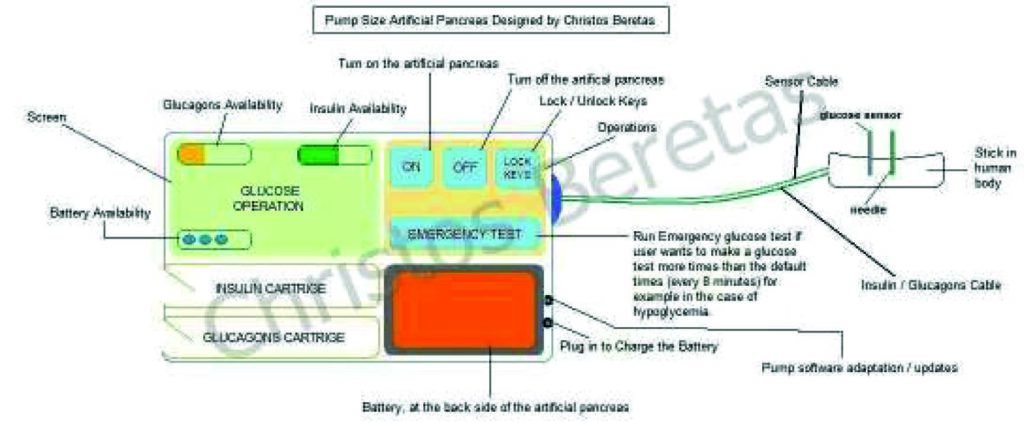Objective:
Pump size exterior artificial pancreas that will keep the glucose between 120 – 150 mg/dl.
Method:
The whole project based in idea that we should already know one insulin unit how much is able to go down the glucose and one glucagons unit how much is able to increase the glucose. Less than 120 mg/dl it uses glucagons. More than 150 mg/dl it uses insulin. The pump checks the glucose automatically every 8 minutes. The pump (which is software decision) will choose between insulin or glucagons base in internal database table with prerequisite glucose values and the insulin or glucagons units requiring for the each glucose value (adaptive database table for each diabetic). The pump (the software) is able to choose how many insulin or glucagons units it should use (that is not base on what the diabetic will eat, but base on the current glucose level that received from the sensor which is located in human body, needle and sensor are one piece). The insulin should have work duration 8 minutes and works instantly.
Result:
I chose 120 mg/dl as the lowest allowance glucose level because this glucose level is secure for the diabetic (there is a time to prevent big hypoglycaemia).
Conclusion:
This project offer to diabetics insulin injections freedom, hypoglycaemia prevention, run emergency tests, ideally for all ages, endocrinologists will have the software to adapt the internal database table of the pump for each diabetic needs.
The project is designed by Christos Beretas, MSc
http://www.christosberetas.com
c_beretas@yahoo.com
(+30) 693-890-9477
Exterior Artificial Pancreas Project by Christos Beretas | www.christosberetas.com |
Artificial Pancreas Presentation and Analysis
The pump size exterior artificial pancreas (Picture 1), uses one sensor (the sensor is one material which include the needle that require to inject to human body both glucagons or insulin, when the sensor is replacing, replace the needle too, is one device with two operations) to collect the current glucose levels from the human body, when the sensor collect the current glucose level, send the data to the artificial pancreas through a cable, then the artificial pancreas read the received glucose value and through table with prerequisites insulin and glucagons units for each received glucose value decide how many insulin units require to decrease the glucose or how many glucagons units require to increase the glucose to prevent hypoglycaemia. My logic is below 120 mg/dl to use glucagons and above 150 mg/dl use insulin (I chose 120 as the lower level for safety purposes, because the artificial pancreas has the time to increase the glucose in next 8 minutes that will check automatically the glucose and if the glucose goes down will automatically increase it without the diabetic to feel hypoglycaemia, I think glucose need some time goes down from 120 mg/dl until feeling hypoglycaemia, I think there is a time to prevent it). The artificial pancreas is remaining standby when the glucose is between 120 – 150 mg/dl. I set the artificial pancreas to make auto glucose tests every 8 minutes, while I added “emergency test” button which the artificial pancreas is able to do current glucose test and chose either glucagons or insulin, this button is useful for hypoglycaemia or hyperglycemias cases.

Usage:
· The goal of the above pump size exterior artificial pancreas is to keep the glucose between 120 – 150 mg/dl.
· Less than 120 mg/dl it uses glucagons.
· More than 150 mg/dl it uses insulin.
· The pump checks the glucose automatically every 8 minutes.
· The pump (which is software decision) will choose between insulin or glucagons base in internal table.
· The user by pressing the “emergency test” button is able to do glucose test (extra test) which the pump will decide to use insulin or glucagons (base on the result).
· The pump (the software) is able to choose how many insulin or glucagons units it should use (that is not base on what the diabetic will eat, but base on the current glucose level).
· Automatically the pump notifies the user for low levels of buttery, insulin, and glucagons.
· I chose 120 mg/dl as the lowest allowance glucose level because this glucose level is secure for the diabetic (there is a time to prevent hypoglycemia) generally the diabetic needs more than 8 minutes to feel hypoglycemia, the pump run automatically tests every 8 minutes. Thus, the pump will prevent the hypoglycemia because have the time to do that.
· Between the glucose results (120 – 150 mg/dl) the artificial pancreas is in standby mode, because these glucose levels are normal for the pump. Also, the· Between the glucose results (120 – 150 mg/dl) the artificial pancreas is in standby mode, because these glucose levels are normal for the pump. Also, the artificial pancreas is remain standby when it is not able to receive any data’s from the sensor, while notify the diabetic by continuous sound.
· Endocrinologists they will have the software to adapt the internal database table of the pump for each diabetic needs.· The goal of the above pump size exterior artificial pancreas is to keep the glucose between 120 – 150 mg/dl.
· Less than 120 mg/dl it uses glucagons.
· More than 150 mg/dl it uses insulin.
· The pump checks the glucose automatically every 8 minutes.
· The pump (which is software decision) will choose between insulin or glucagons base in internal table.
· The user by pressing the “emergency test” button is able to do glucose test (extra test) which the pump will decide to use insulin or glucagons (base on the result).
· The pump (the software) is able to choose how many insulin or glucagons units it should use (that is not base on what the diabetic will eat, but base on the current glucose level).
· Automatically the pump notifies the user for low levels of buttery, insulin, and glucagons.
· I chose 120 mg/dl as the lowest allowance glucose level because this glucose level is secure for the diabetic (there is a time to prevent hypoglycemia) generally the diabetic needs more than 8 minutes to feel hypoglycemia, the pump run automatically tests every 8 minutes. Thus, the pump will prevent the hypoglycemia because have the time to do that.
· Between the glucose results (120 – 150 mg/dl) the artificial pancreas is in standby mode, because these glucose levels are normal for the pump. Also, the artificial pancreas is remain standby when it is not able to receive any data’s from the sensor, while notify the diabetic by continuous sound.
· Endocrinologists they will have the software to adapt the internal database table of the pump for each diabetic needs.
Synopsis:
There are two important points, the first one is the insulin, the pump automatically run tests every 8 minutes, thus we can’t use insulin that have a duration one, three, or six hours, this pump needs insulin that have duration 8 minutes and it should work immediate (we should know both how much one insulin unit decrease the glucose in mg/dl and how much one glucagons unit increase the glucose in mg/dl to make the best table). The second point is the kids with diabetes below of 10 years old require usually less insulin units, this artificial pancreas is not able to determine the age of the people, for example, cannot be use in 10 years old diabetic, because his/her body require less insulin units than a 25 years old or older diabetic. To overcome this limitation, endocrinologists they will have the software to adapt the internal database table of the pump for each diabetic needs including the need that is require for example a 10 year old kid.
Exterior Artificial Pancreas Project by Christos Beretas | www.christosberetas.com |

Sign Up to Our Newsletter to Get Latest Updates & Services
Paris Graduate School © 2024 | All Rights Reserved | Privacy Policy
| Cookie | Duration | Description |
|---|---|---|
| cookielawinfo-checkbox-analytics | 11 months | This cookie is set by GDPR Cookie Consent plugin. The cookie is used to store the user consent for the cookies in the category "Analytics". |
| cookielawinfo-checkbox-functional | 11 months | The cookie is set by GDPR cookie consent to record the user consent for the cookies in the category "Functional". |
| cookielawinfo-checkbox-necessary | 11 months | This cookie is set by GDPR Cookie Consent plugin. The cookies is used to store the user consent for the cookies in the category "Necessary". |
| cookielawinfo-checkbox-others | 11 months | This cookie is set by GDPR Cookie Consent plugin. The cookie is used to store the user consent for the cookies in the category "Other. |
| cookielawinfo-checkbox-performance | 11 months | This cookie is set by GDPR Cookie Consent plugin. The cookie is used to store the user consent for the cookies in the category "Performance". |
| viewed_cookie_policy | 11 months | The cookie is set by the GDPR Cookie Consent plugin and is used to store whether or not user has consented to the use of cookies. It does not store any personal data. |